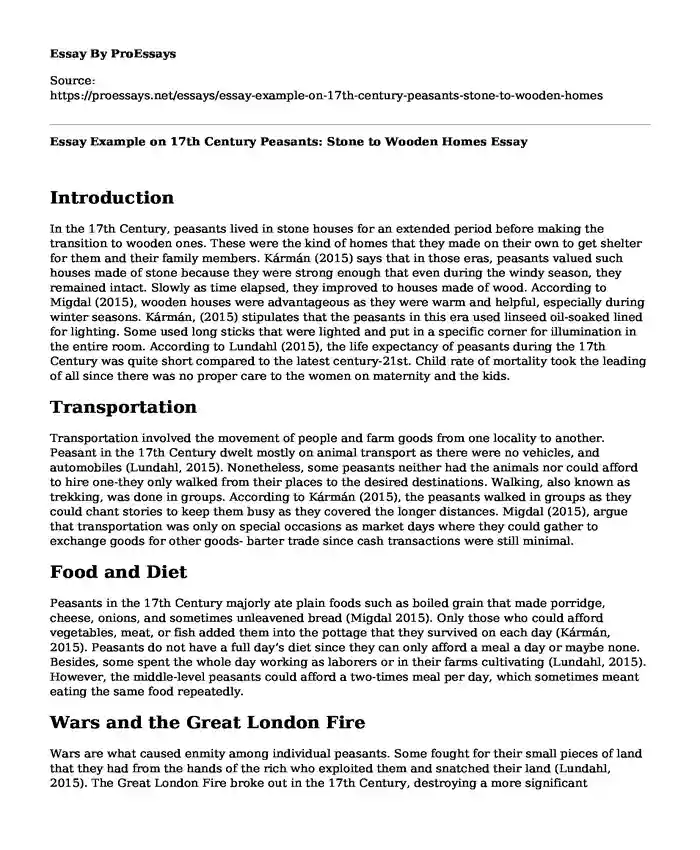Introduction
In the 17th Century, peasants lived in stone houses for an extended period before making the transition to wooden ones. These were the kind of homes that they made on their own to get shelter for them and their family members. Kármán (2015) says that in those eras, peasants valued such houses made of stone because they were strong enough that even during the windy season, they remained intact. Slowly as time elapsed, they improved to houses made of wood. According to Migdal (2015), wooden houses were advantageous as they were warm and helpful, especially during winter seasons. Kármán, (2015) stipulates that the peasants in this era used linseed oil-soaked lined for lighting. Some used long sticks that were lighted and put in a specific corner for illumination in the entire room. According to Lundahl (2015), the life expectancy of peasants during the 17th Century was quite short compared to the latest century-21st. Child rate of mortality took the leading of all since there was no proper care to the women on maternity and the kids.
Transportation
Transportation involved the movement of people and farm goods from one locality to another. Peasant in the 17th Century dwelt mostly on animal transport as there were no vehicles, and automobiles (Lundahl, 2015). Nonetheless, some peasants neither had the animals nor could afford to hire one-they only walked from their places to the desired destinations. Walking, also known as trekking, was done in groups. According to Kármán (2015), the peasants walked in groups as they could chant stories to keep them busy as they covered the longer distances. Migdal (2015), argue that transportation was only on special occasions as market days where they could gather to exchange goods for other goods- barter trade since cash transactions were still minimal.
Food and Diet
Peasants in the 17th Century majorly ate plain foods such as boiled grain that made porridge, cheese, onions, and sometimes unleavened bread (Migdal 2015). Only those who could afford vegetables, meat, or fish added them into the pottage that they survived on each day (Kármán, 2015). Peasants do not have a full day’s diet since they can only afford a meal a day or maybe none. Besides, some spent the whole day working as laborers or in their farms cultivating (Lundahl, 2015). However, the middle-level peasants could afford a two-times meal per day, which sometimes meant eating the same food repeatedly.
Wars and the Great London Fire
Wars are what caused enmity among individual peasants. Some fought for their small pieces of land that they had from the hands of the rich who exploited them and snatched their land (Lundahl, 2015). The Great London Fire broke out in the 17th Century, destroying a more significant percentage of properties for the peasants and the rich (Kármán, 2015). According to Migdal (2015), the peasants lost their farm produce ready for harvesting and the little houses they had. Many individuals lost their lives in the same event.
Conclusion
Peasants are small farmers with insufficient and less privilege in the social status ranking. The lives of the peasants revolve around the little pennies they get and strain to settle living expenses such as putting food on the table, paying for kids' school fees, paying rent, and paying tax to the state's government. Peasants worked hard for less and had limited ownership of land. They depended on one meal per day or two for those who had small farms to cultivate. Their mode of transport was animal and walking. Life expectancy till to date is low since there's a high mortality rate for both infants and adults, as there are limited resources to cater for that.
References
Kármán, G. (2015). A Seventeenth-Century Odyssey in East Central Europe: The Life of Jakab Harsányi Nagy. Brill.
Lundahl, M. (2015). Peasants and Poverty (Routledge Revivals): A Study of Haiti. Routledge.
Migdal, J. S. (2015). Peasants, politics, and revolution: Pressures toward political and social change in the Third World. Princeton University Press.
Cite this page
Essay Example on 17th Century Peasants: Stone to Wooden Homes. (2023, Sep 25). Retrieved from https://proessays.net/essays/essay-example-on-17th-century-peasants-stone-to-wooden-homes
If you are the original author of this essay and no longer wish to have it published on the ProEssays website, please click below to request its removal:
- How Does Childhood Attachment Style Affect The Ability To Build And Maintain Relationships In Adulthood?
- Essay Sample on World War Two as an Unpredictable Historical World Event
- Essay Sample on Effective Persuasive Communication
- American Horizons Questions Paper Example
- Essay Example on Geographical Closeness and Distance in Relationships
- Essay Sample on Amish: Working Together for Unity & Stability
- Essay Example on Founders of the US: An Intergovernmental Perspective







